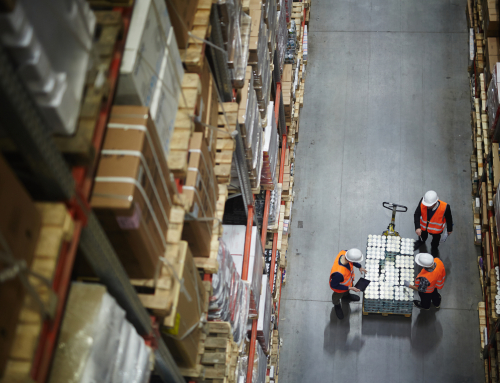In a market where the customer experience is
more important than ever, CRE brokers can team up with an on-demand warehousing
partner to add value. Here’s how.
In reading Deloitte’s newly
released 2020 Commercial Real Estate Outlook, this statement really
caught my attention: “As we look to the milestone year of
2020, it has become urgent for CRE companies to prioritize tenants’ and end
users’ needs, given the increasing influence of technology and changing
customer preferences.”
Essentially, the traditional
focus on “location, location, location” is increasingly shifting to “location,
experience, analytics.” The focus on experience has emerged as such a crucial
factor that it has given rise to ROX, a new
performance management metric that captures a company’s return on its
investment in customer experience (CX) and employee experience (EX).
New demands put emphasis on tenant experiences
Consumer
demand for more personalized, expedient, interactive, on-demand experiences has
the CRE industry embracing a range of innovative technology (such as CBRE’s
Host, an enterprise-grade smart workplace platform, and JLL’s PinPoint, a
geofencing tool for the analysis of consumer behavior). Developers and
management must pledge to keep technology investments high, even in the face of
an economic downturn, as the concept of real estate-as-a-service is taking hold
and tenants change the way they engage with physical space.
Simultaneously, tenants are changing the way they do business — which affects the way they approach real estate. They must make their supply chains more responsive to market fluctuations, introduce operational agility, get closer to customers to facilitate last-mile delivery, and explore new markets before making long-term lease commitments.
While the transformation of the retail landscape — stores as
showrooms, interactive shopping, the demise of malls — tends to garner the most
media attention, Deloitte notes the elevation of the tenant experience applies to
every aspect of the supply chain, including warehousing.
On-demand economy reshaping expectations
Consider this observation from
Deloitte:
“Tenant
experience is a top priority for most CRE leaders. The on-demand economy is
reshaping tenant expectations about how real estate is consumed, and
technology-enabled facilities and personalized experiences are already
transforming the CRE industry. Today, creating superior experiences is not
just about engaging the tenant. It is also about extending services to the CRE
“end user,” or the day-to-day consumer of that space: a retail shopper; a
resident living in a multifamily property; an employee working in an office
space; or a manufacturer using a warehouse.”
But how can CRE brokers extend that additional service element to
clients for an enhanced experience? When we speak to CRE brokers they are
sometimes surprised to learn how a partnership with an on-demand warehousing
company like Warehowz can add value to the experience of their customers.
On the surface it may seem that CRE brokers, who specialize in long-term warehouse leases, and on-demand warehousing, which fills a need in the marketplace for short-term space, are not a natural fit. But CRE brokers can actually benefit from adding on-demand warehousing as a tool in their portfolio of services, as it helps to groom leads for future business.
Let’s take a look at three examples where CRE brokers
can leverage on-demand warehousing to enhance their service offerings:
1. Nurture leads
Companies are, by design, risk averse. Without a solid growth
forecast that shows demand will remain high for years to come, they are
unlikely to take a chance on an unexplored area. For startups in particular,
such long-term growth forecasts are notoriously unpredictable, making them even
less likely to dive in. In the past, CRE brokers may have had to turn away such
companies — and risk losing their business for good.
An on-demand warehousing partner can change that dynamic by
nurturing leads until they are ready for a long-term commitment. In a warehouse
market with a historically low vacancy rate of 4.8%, according to Heitman
research presented at the recent VCU Real
Estate Trends Conference, long-term
lease rates will naturally be more favorable and attractive to tenants.
2. Expand portfolio of services
Few companies are using a
uniform set of warehouse leases. Instead, their portfolios consist of a mixture
of leased warehouses, 3PLs, and —
increasingly — on-demand. To stay competitive in such an environment, CRE
brokers should consider expanding their portfolio of services to include
on-demand warehousing. A CRE client who just signed a long-term lease may still
need on-demand space elsewhere. A partnership enables that client to leverage
Warehowz’s cloud-based platform. The result: a solution that follows the mantra
“location, experience, and analytics,” and, by extension, fosters customer
satisfaction by improving service offerings.
3. Tackle overflow needs
A
CRE client is experiencing an overflow need, but the new warehouse space is six
months to a year from completion. What should the company do during the construction?
With an on-demand warehousing partner, the CRE broker can present a flexible
offer: short-term space is available right in the area. Again, it means a
valued client receives enhanced service.
And this last Deloitte statement
rings very true:
“It’s now or never for the CRE industry. CRE
leaders should be proactive and preemptive, open the aperture, and embrace and
adapt to the winds of change.”
Want to know how Warehowz can
help your business thrive? Contact us today.
Read more:
Warehowz and Estes Announce Partnership with Investment and Integration of Sales
Three Product Companies, Three Ways to Unlock Supply Chain Flexibility



